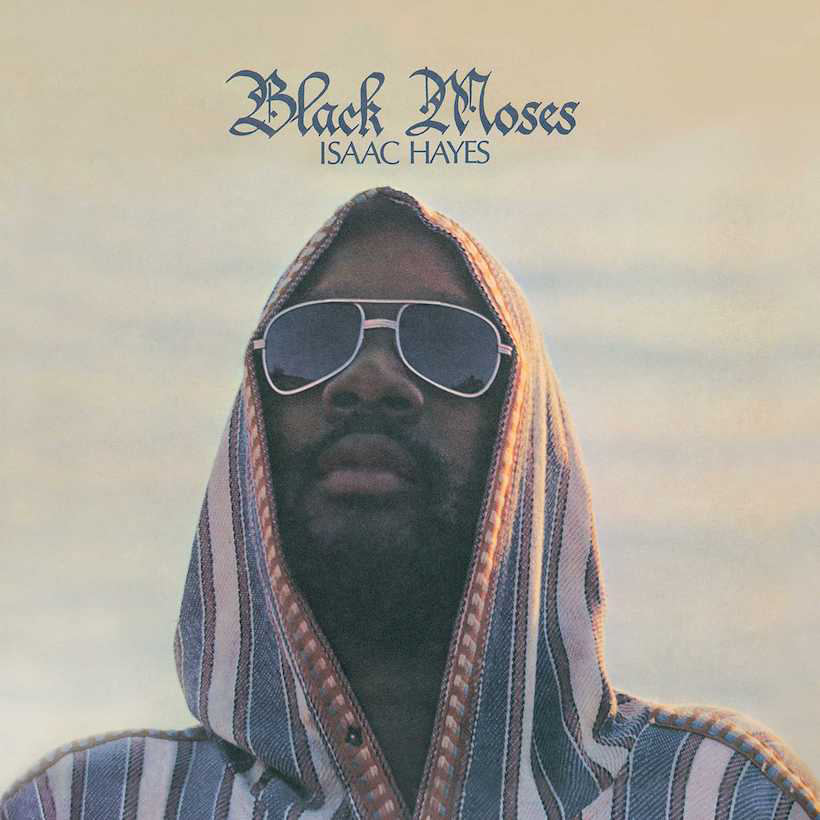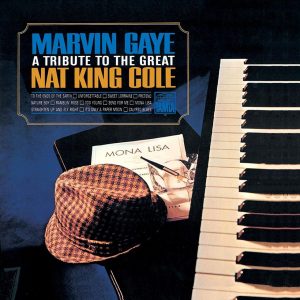In the space of just 28 months, between early summer 1969 and November 1971, Isaac Hayes released five albums, of which two were double-LPs. All five records were huge hits that topped the US R&B charts, with one, Shaft, making No. 1 on the US album charts. Three others entered the main Top 10, while the lowest placed ranked just outside, at No. 11; four of them even topped the US Jazz chart, while the last released, Black Moses, made it to No. 2. This was success on a grand scale.
Black Moses was released as a double-album in late November 1971, and by early December it was climbing the Billboard chart to its No. 10 peak. And yet it remains somewhat overlooked today, perhaps suffering for following his brilliant first three solo albums for Stax Records, Hot Buttered Soul, The Isaac Hayes Movement and … To Be Continued – and not forgetting his groundbreaking Blaxploitation soundtrack for Shaft.
Isaac Hayes as Black Moses
Black Moses was recorded between March and October 1971, in the middle of the period when Hayes recorded the Shaft soundtrack. But who came up with the idea of naming the album? According to Isaac Hayes it was Dino Woodard, one of his inner circle: “Dino said, ‘Man, look at these people out there. Do you know what you’re bringing into their lives? Look at these guys from Vietnam, man. How they’re crying when they see you, how you helped them through when they was out there in the jungle and they stuck to your music. You like a Moses, man. You just like Black Moses, you the modern-day Moses!’” Woodard, a former boxer and sparing partner of Sugar Ray Robinson, later became a Baptist minister; he passed away in 2014.
At a gig at Harlem’s Apollo Theater, Hayes was even introduced to the audience as “Black Moses,” and while he found the term somewhat sacrilegious, he eventually came to embrace it following its use in an article in Jet magazine; Stax executive Larry Shaw had the savvy to capitalize on it and call the double album, Black Moses.
Going this route – saying, in effect, that he was the most important black artist in America – became something of a burden for Hayes. It’s worth remembering that, six months before he released Black Moses, Marvin Gaye put out the game-changing What’s Going On – this really was a time of intense creativity for soul music. Add to this the fact that Black Moses was released just a week or so after Shaft had topped the album charts… Hayes was in danger of overload.
Shaw, who was in charge of Stax’s art department, had made great strides in improving the label’s album cover art, but nothing he did before – or after – can compare with the artwork for Black Moses. It has been cited as one of the greatest album covers ever. Shaw dressed Hayes in robes and went for Moses-lookalike overkill when the photograph was shot. But what makes this cover so amazing is not simply the image, it is the fact that the two records were encased in a sleeve that folded out into the shape of a four-foot-high, three-foot-wide cross. For some, Hayes really was Moses!
Side One of Black Moses
The album’s 14 tracks were spread over all four sides of the two LPs, with every track running way longer than an average for the time – the shortest was a few seconds under five minutes, and four songs were over nine minutes in length.
The opener, “Never Can Say Goodbye,” released in early 1971 by Jackson 5, who took it No. 2 in the charts, was issued as the lead single from Black Moses in May 1971, six months before the album came out. In its original form it runs for over five minutes, but the single was cut back to three and a half minutes, which took away some of its magic; nevertheless, it still made No. 22 on the Hot 100. Backed by The Bar-Kays, Ike, who plays Hammond organ and vibes on the record, takes the song at a much slower pace than the Jacksons, and in so many ways this version sets the template for the record.
Black Moses, like most of the music on Hayes’ first three solo albums, is made up of cover versions, among them Side One, Track Two, the monumental rendition of Burt Bacharach and Hal David’s “(They Long to Be) Close To You.” The song had been Carpenters’ first No. 1 record a year or so before, and, in typical Ike fashion, he takes it and turns it on its head.
Opening with female backing singers (credited as “Hot”, “Buttered” and “Soul” on the sleeve), and it’s not until two minutes in that Hayes himself makes his triumphal vocal entry – it’s one of the moments on any of his recordings, right up there with the vocal on Hot Buttered Soul’s “By The Time I Get To Phoenix.” The strings, guitars, and Ike’s piano are just sublime: the epitome of soul music. It’s also the first of the nine-minute epics on Black Moses (though it’s slightly disappointing that Ike didn’t take it out longer).
It’s a tough song to follow, but is certainly given a run by a version of Toussaint McColl and Alan Robison’s “Nothing Takes The Place Of You,” for which Hayes delivers one of his finest ever vocal performances, backed by his own Hammond organ that greatly adds to the mood. Side One finishes with “Man’s Temptation,” a superb Curtis Mayfield song that Gene Chandler had a minor hit with. On any other album this would be a standout song; here it is less prominent, but no less excellent.
Side Two of Black Moses
“Never Gonna Give You Up,” written by Philadelphia International’s Kenneth Gamble and Leon Huff, along with Jerry Butler, is surprising, since it opens with deceptively upbeat backing vocals and Gary Jones’ bongos, yet they give way to an aching Hayes vocal that speaks to his hurt. Like so much of Black Moses (and much of Ike’s music in general), the song tells of loves lost and men cheated and beaten.
The first of Ike’s “Raps” (confusingly titled “Ike’s Rap II,” though there is no “Ike’s Rap I”) precedes “Help Me Love” – on which Sidney Kirk’s piano playing is just wonderful – while the song itself is “on message” with the rest of the album, as well as being beautifully arranged. In 1995, British trip-hop pioneers Portishead sampled “Ike’s Rap II” in their song “Glory Box,” while fellow Bristolian artist Tricky used the same sample for his song “Hell Is Round The Corner.” More recently, “Ike’s Rap II” was been sampled for Alessia Cara’s breakout single “Here,” which reached No. 15 on the Billboard Hot 100 in 2015.
The second Curtis Mayfield song on Black Moses is “Need To Belong To Someone,” and was also a hit in 1963, when sung by Jerry Butler. As ever, Hayes takes it into uncharted territory with a stunning orchestral arrangement, coupled with a longing vocal delivery that should make a believer out of everyone. By way of juxtaposition, the Hayes co-write “Good Love” is funky, upbeat, and full of great vibes.
Side Three of Black Moses
“Ike’s Rap III” prefaces “Your Love Is So Doggone Good,” another album-defining track – smoldering and sexy in the extreme. It’s a great riff that has layer after layer, producing a spine-tingling effect. This is Isaac Hayes at his very best, and the song gives way to a surprising outro that is surprising cries out to be sampled.
The sequencing on Black Moses is part of what makes it work so well, as you will hear when Kris Kristofferson’s “For The Good Times” follows, as the second track on Side Three. Understated, beautiful, sad, and emotional, Hayes’ version takes a song that topped the Country charts and turns it into a soul classic. Never doubt that the two are kissin’ cousins – just listen to that horn section!
Side Three closes with “I’ll Never Fall In Love Again,” another Bacharach and David song that’s almost an answer song to “For The Good Times.” Originally a hit for Bobbie Gentry, having been debuted in the musical Promises, Promises, it is beautifully delivered, with Hayes accentuating the superb Bacharach melody in all the right places. It also highlights what a really good singer Hayes could be: he embraces the lyrics and makes you believe that he had lived every syllable.
Side Four of Black Moses
“Part-Time Love” opens the fourth and final side with its orchestra-punctuated wah-wah guitar. Written by Clay Hammond, this was yet another hit from 1963, and an R&B No. 1 for Little Johnny Taylor. Isaac Hayes was would have turned 21 in 1963, and the amount of Black Moses songs taken from that year show how important it was to the man from Tennessee, who, in ’63, was working in a Memphis meat-packing factory by day and playing jook joints by night.
Ike’s third and final “Rap” (“Ike’s Rap III”) gets us in the mood for the Gamble, Huff and Butler’s “A Brand New Me,” a song that Jerry Butler had a minor hit with in 1969, and which both Dusty Springfield and Aretha Franklin covered. If we’re sounding like a broken record, we’re sorry, but yet again Isaac Hayes takes this song to places that no one had hitherto dreamed it could go.
It builds and builds and leaves the listener in a crumpled heap as it climaxes. Say it loud – he’s Black Moses and proud. It’s an awesome track.But how to close the album? Any normal person would have thought “A Brand New Me” was impossible to follow, but not Hayes. He saved the best for last. “Going In Circles,” written by Jerry Peters and Anita Poree, and a No. 15 hit for The Friends Of Distinction in 1969, is simply breathtaking.
Skip Pitts’s guitar, the orchestra, along with Hot, Buttered and Soul, drive this opus to giddy heights of decadent lust, allowing Isaac to deliver his greatest ever vocal performance. As he sings “Strung out over you” and the girls answer with “Going in Circles”, and the French horns of the Memphis Symphony Orchestra provide a cushion of sound, it is impossible not to be deeply affected.
And then it’s over.
Isaac Hayes’s finest album…? Probably. Black Moses is full-on: magnificently conceived, over the top, beautifully arranged, played, and sung.




